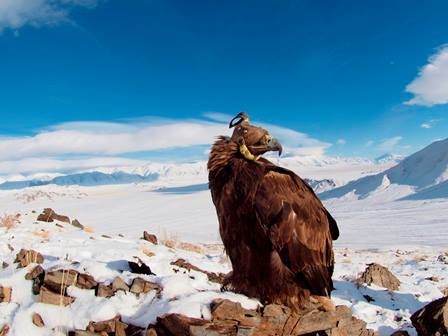Foxhunting on the grand Steppes of Mongolia not with hounds but with an eagle - what an exciting idea! Such an adventure had been ruminating in my brain for several years and I finally found Boojum Expeditions, a travel agency who arranged adventure trips including eagle hunting in Mongolia. My due diligence proved positive so I asked my wife and then some friends if they might join me on such an expedition. The consensus seemed to be, "What! Go to Mongolia with you!" Undeterred, I signed on to Boojum's next trip scheduled to commence from Ulaan Baatar, the Capital of Mongolia, November 9, 2000.
I departed Washington Dulles Saturday evening November 4 and fourteen hours later arrived in Seoul, Korea where I planned a couple of days of sightseeing. Thursday morning, November 9, I boarded a plane to travel 1,300 miles Northwest to Ulaan Baatar just about in the middle of Mongolia. Mongolia straddles the 48th parallel which forms the border between The United States and Canada. This country is a high plateau of prairie, desert, and mountains with very little rainfall, only a few inches a year. It is about one-sixth the size of the United States including Alaska and has a population of 2.4 million people, 5 per square mile compared to 75 people per square mile in the United States and 625 per square mile in Great Britain. 90 percent of the population is Mongolian (Asian), 5 percent Kazakh (Turkic), a few Chinese and others.
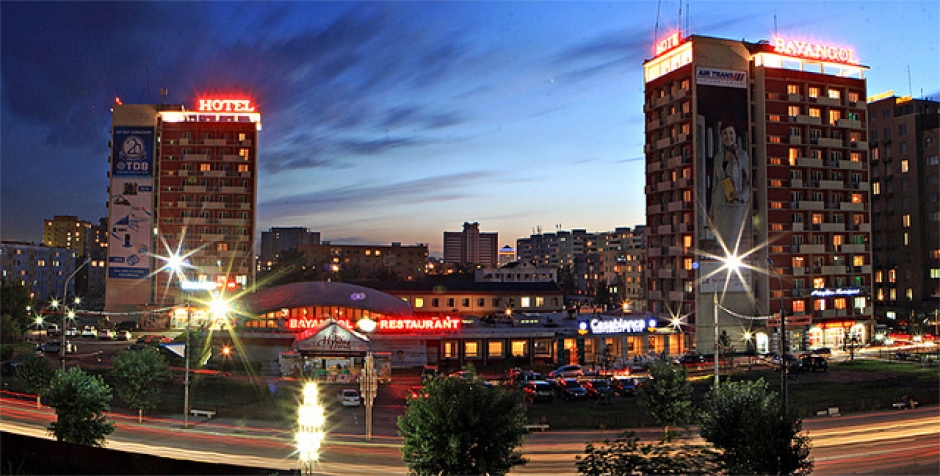
It was in Ulaan Baatar (U.B.) that I met the four other members of our party. Alan Gates from Yorkshire, England, a falconer all his life, had raised trained, flown and hunted eagles for twenty years. Alan used to hunt with a pointer and an eagle. The eagle flew free overhead watching and the dog hunted birds below. When the dog found a bird and went on point, the eagle would fly in a little closer. Alan would flush the bird and the eagle would streak out of the sky nailing the bird. Imagine, eagle, dog, and man all cooperating to hunt the same quarry! Becky Rex and Robin McCarty were members of a falconry club in Denver, Colorado and Paul Watts was a hunter/adventurer from San Francisco. In U. B. we were shepherded about by Gongor, our Mongolian guide. The Mongolians are a good looking, strong people with good teeth and a full head of hair. I was stared at by many people on the street particularly the children, there was a big-nosed westerner with a little white hair and wearing glasses; practically no one in Mongolia wears glasses. After a day and a half of seeing the sights of the Capital, we boarded a workhorse of a Russian-built prop-jet which flew us 750 miles West to Olgii, a town of about 25,000 one hundred miles from the Russian border. In Olgii we were met by Canat and Ika our Kazakh guides who showed us the sights of the town. The "town" had few hard roads and featured feral dogs running loose and an open-air market. Here was a camel market next to the vegetable stand, next to the horse market, next to the meat market. And all this open-air market activity was going on in temperatures close to zero. The U. S. Department of Agriculture would have been frenetic! We bedded down in our sleeping bags in Canat's apartment, girls in one room, boys in the other. The entire town was heated by one central steam heating plant which the city fathers shut down about ten o'clock at night. It got chilly. In front of the apartment, a dumpster provided forage (insulation, I think) for cattle wandering loose about the town and tidbits for a few feral cats. The cows and cats supped happily side by side. After a day and a half of Olgii, we all piled into Canat's Russian Army troop transport truck and commenced the three-hour drive to camp.
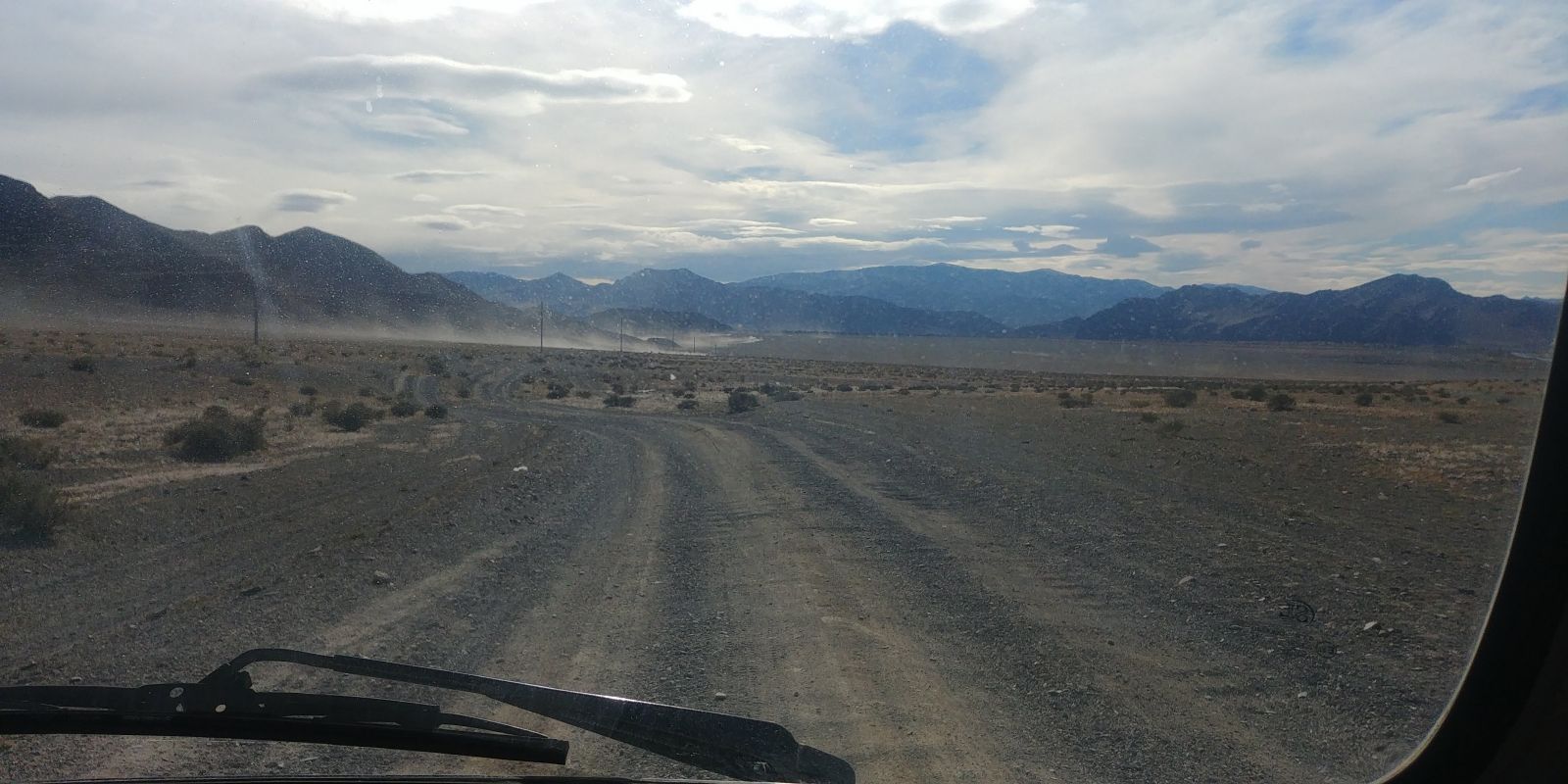
Within a mile from Olgii, the roads turned to dirt and bumps. Along the way, the scenery became more and more vast and beautiful as we headed into the foothills of the Altai Mountains which soar up to 15,000 feet. En route, we passed a Mongolian herder on his way home on his pick-up truck. In western Mongolia, a pick-up truck is a Bactrian camel, a two-hump, longhaired camel as opposed to the one-hump Dromedary camel usual to North Africa and the Middle East. As we rolled into camp our hosts Kakiyat, Kylai, and their five children greeted us. These descendants of Genghis Khan were living much as he and his horde did 800 years ago. We were immediately ushered into the house, a one-room structure of mud-plastered logs with a dirt roof, very like a Navajo Hogan. There was no telephone, no electricity, no running water or "facilities." The "facilities" were outside - anywhere. The central heating/cooking unit was a heavy tin stove burning dung. The water supply was a pile of ice out in the yard. About once a month they go to the river eight miles away to cut ice for their water supply. When water was needed Kylai or one of the children would go to the ice pile, chunk off a few pieces and bring them in to melt. Five adventurers, three guides, and seven Kazakh hosts all slept in the "Hogan."
The Kazakh people of Western Mongolia are nomadic herders tending sheep, goats, horses and a few camels. They move about Spring, Summer and Fall from one pastureland to another living in their felt tents called gers often referred to as "yerts," the Russian word for ger. Since the departure of the Russians in 1991, the Mongolians have been returning vigorously to their own customs and culture. It is a hard life and the Kazakh herders cannot afford to waste anything including time.
From October to May Mongolia is cold, very cold. Most people wear furs of one sort or another so there is a healthy market for good pelts. Hunting for fur-bearing animals is a serious commercial activity for the Kazakh Mongolians and their strike hounds are eagles. They have been hunting with eagles for generations. The Western World was first exposed to hunting with birds, falconry when the Crusaders invaded the Middle East in the Eleventh Century and with the travels of Marco Polo in the Thirteenth Century.
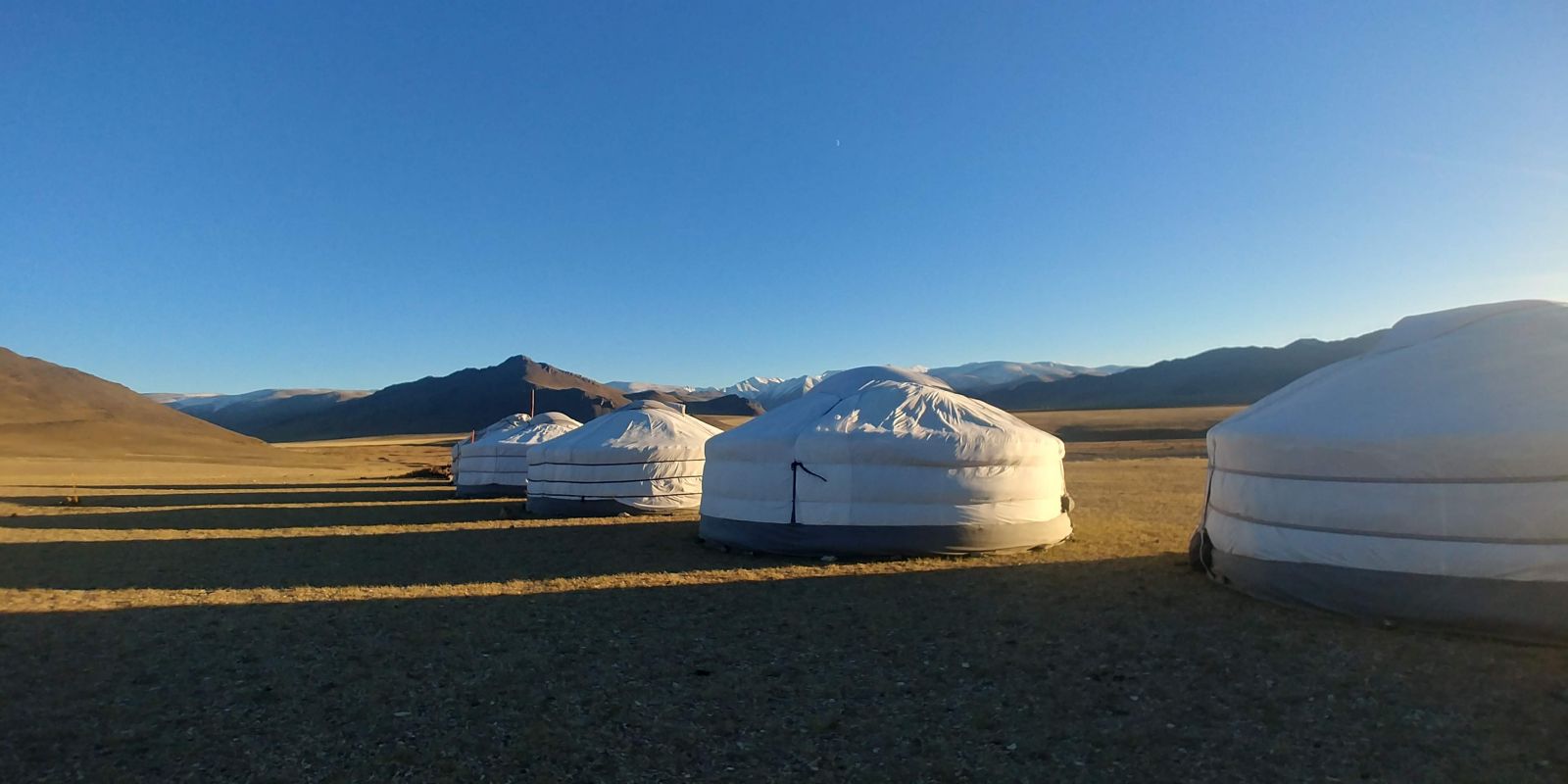
The Kazakh eagle hunters take wild fledgling eagles from their nest at about six weeks of age in April or May. These are Golden Eagles, the most ubiquitous eagles in the world, just like the ones we see in the Western part of the U. S. Only females are taken as they are larger and more aggressive. The fledgling is tied to a rock or stump in a lonely place for a week or so visited once a day by the eagle master to feed and water her. In time, the man is imprinted on the eagle and they bond. The eagle is then brought home and the training begins. The eagle Master feeds and waters the eagle and in time, the eagle master moves a short distance from the tethered eagle enticing her with bits of raw meat. The distance between eagle and master grows and eventually, the untethered eagle will come to Master on her own volition. After several weeks, training is moved outside and a stuffed rabbit is introduced. The son of the eagle Master will drag the stuffed rabbit along the ground a short distance from the eagle who is then let loose. Her strong instinct to hunt and kill usually takes over and she pursues and captures the stuffed rabbit. The eagle mantles her prey, spreading her wings over it to protect and hide it from potential pirates. Master immediately rewards her with some meat. Soon the eagle will regularly stay with her captured prey until Master arrives with a reward. True hunting can begin in September or October.
The morning after our arrival we arose about 8:00 AM and were ready to mount our ponies for the hack to the first covert by 9:30. The ponies were tough little Mongolian horses 13 to 14 hands. I rode one pony seven hours a day, three days in a row. He seemed totally unfazed. The bridles are of simple rawhide carrying a curved snaffle bit. While in the Museum of Natural History in Seoul I saw the relics dug from an archeological site dating from about the time of Christ. There were a number of equestrian items including a bit. The bits we used with our little Mongolian ponies were just like the one I saw in the museum. The saddles consisted of two pieces of fencing board about a foot and a half long bolted together with a curved iron bar at each end so that the boards would sit lengthwise on either side of the withers and backbone. The girth billets and stirrup leathers were attached through two notches cut in each board. Two thick pieces of felt were placed between the saddle and the pony's back and a pillow was tied on top of the saddle - that was it. The Mongolians prize their ponies greatly and breed them carefully. The mares are selected with as much care, maybe more, as the stallions.
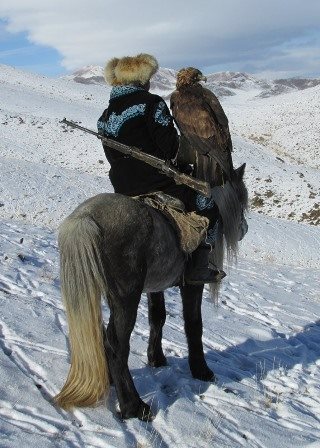
Hacking about an hour to the first covert we traversed slightly rolling upland prairie studded with rocks sloping down to Great Plains, lakes, and valleys below. The Altai Mountains rose up miles away on the other side of the valleys, a bleak and barren moonscape but awe-inspiring in its' grandeur and beauty. This was the biggest "big-sky" country I had ever seen. Master removed the eagle's hood as he began to hunt. This covert was a barren hill of rock outcroppings and boulders which afforded many crannies and little caves in which a fox or hare could hide. While we rode below watching, master traversed back and forth across the hilltop hoping to scare out a fox. If one were viewed, and be assured the eagle would see him first, Master would free the eagle simply be releasing the jesses (leather thongs attached to the eagle's legs) gripped between his thumb and forefinger. In a flash, the eagle was off in pursuit of her quarry soon to stoop in her final strike. In stooping, a raptor (bird of prey) executes a dive-bombing-like maneuver at high speed to strike her prey. Upon landing on the back or shoulders of the victim the eagle sinks her mighty talons into it breaking its' neck or back. While a fit hunting eagle only weighs eight to ten pounds, she can exert 400 to 600 pounds pressure per square inch with those terrible talons. The Mongolian fox is a red foxlike ours but stands two to three inches taller at the shoulders and is usually colored like the blondest of our foxes.
After a lunch break, coffee from a thermos, cheese, and bread, Master asked me to ride with him right in his hip pocket; I was honored. We scoured along hilltops dusted with snow, barren and rocky with a precipice often dropping off to either side. I would never have dreamed of riding a horse in such terrain but Master preceded me most unconcerned so I followed. Our barefooted, intrepid little ponies pressed on without fear never slipping or stumbling. I think the Mongolians must cross in a little mountain goat for their ponies' surefootedness is amazing.
After a while, a fox was viewed but he quickly scampered under an overhang. Master dismounted, placed the eagle free on a boulder and signaled me to follow. The ponies too were left free and they went about grazing awaiting our return. Master instructed me via sign language to make a lot of noise and throw big rocks over the cliff in hopes of spooking the fox out. Now, I have always been taken with a childish enjoyment from throwing big rocks off cliffs and here I was on the Steppes of Mongolia, riding, foxhunting and being asked to yell and throw rocks tumbling and crashing off a cliff - I was in heaven! We were in luck as the fox soon left his cover and made a dash across the small canyon floor just below the eagle. She saw him and departed her perch in a flash wing only partially opened heading straight for the fox. As she approached the fox, he rolled over on his back baring his teeth hoping to scare the eagle. Being young and green, she was a bit startled and executed a less than perfect strike. All the same, there was a scrum of dust, fur, and feathers but the fox escaped streaking over the hill to safety. The eagle stayed quietly at the scene of the battle waiting for Master to come to pick her up. We followed the fox's trail in the light snow for half an hour but no luck. Sometime after 4:00 PM we packed it up and headed for home. On the way, the master's two sons who were whipping to him challenged me to a race. Recalling my timber racing days I put spur to a pony and across the prairie we tore, but the boys had mounted themselves well so the results were predictable. They were highly amused at the sight of this white-haired westerner whipping and flailing his way across the plain. It was only during the long hack home with the approaching dusk and descending temperatures that we suffered from the cold, twenty degrees in the middle of the day and below zero at night. Back at the "Hogan" we warmed ourselves with a shot of vodka (several) and partook of a hearty meal. Our Kazakh hosts were Muslim but happily shared their vodka and gladly helped me smoke Camel cigarettes. Meals at camp consisted of mutton with rice, mutton with noodles and then mutton with rice often mixed with carrots, cabbage, potatoes, and turnips. This meal was served to us twice a day and it stood us in good stead hunting all day.
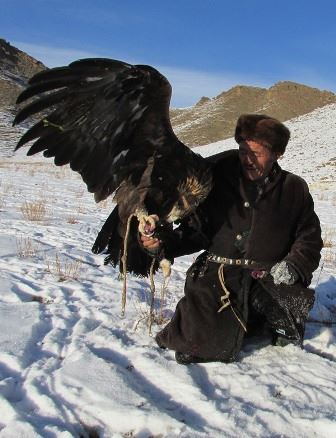
The second day was much like the first but no luck with a fox. Part way through the day Master stopped and made an iceball about the size of your thumb and jammed it down the eagle's throat. He said the iceball sitting in her crop would make her hungry thus encouraging her to hunt better. We saw a couple of hares whom the eagle pursued vigorously but they escaped under a rock. We did see a wild mountain sheep grazing on the hillside across the valley. It was barely visible as its brown coat blended in well with brown terrain behind. On the third day, we took turns, some riding with Master, the rest of us performing a flanking maneuver around the covert. As we came around the corner of a hill being drawn by Master and his eagle (they were out of sight), we suddenly viewed a fox running full speed across a beautiful valley stretching out before us. Sure enough, seconds later along came the eagle in hot pursuit. The fox headed straight for a great mound of boulders fifty yards in diameter in the middle of the valley where he found cover. We dashed for the boulders on hopes of scaring out the fox - maybe more rock throwing! The eagle landed atop the pile patiently waiting for us to produce a fox - no luck. All the same, it was a magnificent sight to see a fox in full run across his country pursued by an eagle. On this, our third and last day in the field, we hacked home full of the sights and sounds of hunting with Kazakhs and eagles on the Steppes of Mongolia.
The next day Kakiyat took us two canyons up the trail to meet his neighbors and farrier. The ponies who take the herds out to graze every day are shod, the rest are not. I was interested to see their shoeing operation. The neighbors greeted us most cordially asking us in for tea, cheese, and cookies. After the social amenities, we repaired to the shoeing. The farrier made his horseshoes from lengths of rebar, the iron rods used to reinforce concrete, and the nails were made from steel wire about the diameter of your little finger. The properly cut lengths of rebar and wire were put into the forge and when red hot the hammering began. Soon a shoe and nails immersed. For showing, the pony had two legs tied together and was thrown to the ground. The other two legs were tied to the first two all now sticking straight up in the air and the shoeing began. With just a little paring with a knife, the feet were ready and on were hammered the shoes. The pony seemed resigned to the whole affair and offered no resistance. I don't think that would work with our thoroughbred hunters. The Kazakhs give no name to their ponies or eagle, indulging in no sentimental anthropomorphism. All the same, they have great respect for their animals. Wild eagles live twenty to twenty-five years in Mongolia, thirty to forty years in captivity. When an eagle has hunted for Kakiyat five or ten years he turns her loose back into the wild. When I asked him why he gave up a perfectly good hunting eagle, he explained that she had served him well, had more than earned her freedom and should be returned to her natural habitat. With her strong instinct to hunt reinforced throughout her life hunting with Kakiyat, the eagle will easily readapt to the natural state.
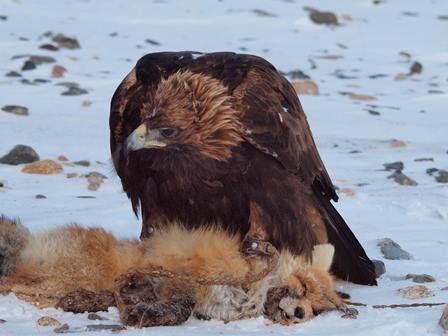
We departed the home of Kakiyat and Kylai with our hearts full of the kindness and generosity of the Kazakh herders who shared their lives and hunting with us. It was my birthday so once back in Olgii, Ika prepared a delicious traditional Kazakh dinner and Canat brought in his friend the Dombro player. A Dombro is a two-stringed musical instrument like a long-necked ukulele. We concluded the day with a wonderful meal, vodka, and much strumming and singing - what a happy birthday!
On our flight back to Ulaan Baatar we landed in Muran to refuel. The flight crew soon learned that U. B. was beset by a blizzard and we must spend the night in Muran, a town that made Olgii look like Washington, D. C. We despaired if we would ever get back to civilization. However, the ever-resourceful Gongor somehow found us a hotel if you could call it that. As we checked in I asked for the "facilities." The innkeeper happily took me to an outhouse right by the front door looking out on the main street of Muran just ten feet away. The outhouse had no seat, just painted footprints where one squat in the bitter cold, watching Muran go by and Muran watching you for the outhouse door was lying out on the ground. Oh well, one's a sense of privacy changes after a week in western Mongolia.
Luck was with us as the storm abated and we flew safely back to U. B. the next day. One more day of shopping and we then parted at the airport boarding our various planes for home. It is a long way to The Altai Mountains but always fresh in our minds will be the sights and sounds of the great Steppes of Western Mongolia and the eagle hunters living there as they have for a millennium.



